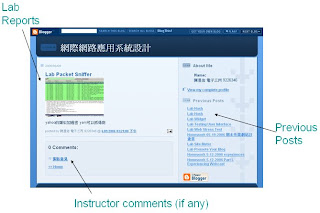1. Introduction
Blogs have found their use in education. For example, blogs often serve as a digital portfolio of students’ assignments and achievements. Most blog platforms provide a personal writing space that is easy to publish, sharable, and automatically archived and empower users to form learning communities by way of inter-linkages. blogs can combine solitary and social interaction in the learning processes.
2. Methodology
First of all, the instructor creates a blog for the lab class at the outset(Figure1). Instructor blogs are they serve to deliver lab sheets and hand-outs in electronic version. Students are encouraged to read the instructor blog before class meets so that they can get themselves prepared.
When finishing a lab in class, students are asked to submit their results at their own blogs immediately and make a notice by placing a link at the instructor's blog where the lab is made public. students can to check into their classmate’s blogs to see what other people have written.
First of all, the instructor creates a blog for the lab class at the outset(Figure1). Instructor blogs are they serve to deliver lab sheets and hand-outs in electronic version. Students are encouraged to read the instructor blog before class meets so that they can get themselves prepared.
When finishing a lab in class, students are asked to submit their results at their own blogs immediately and make a notice by placing a link at the instructor's blog where the lab is made public. students can to check into their classmate’s blogs to see what other people have written.

Figure 1. Instructor blogs are for posting lab materials in the curriculum.
Student-Centric
The blogging approach works in an individual way: not only instructors but also students own blogs. The ownership holds no matter whether the class ends or not. The sense of ownership helps build incentives for students to contribute to and participate in the class while taking the course (Figure 2).
The blogging approach works in an individual way: not only instructors but also students own blogs. The ownership holds no matter whether the class ends or not. The sense of ownership helps build incentives for students to contribute to and participate in the class while taking the course (Figure 2).
Figure 2. Each student posts lab results on her or his blog instead of the instructor blog.
Social Learning
To create deeper dialogues and further the opportunities of social learning, the students who receive comments from his classmates are asked to do two things next. For one thing, they are asked to say thanks, by leaving a comment below the received ones, to the people who have made the comments to their works. For the other, further comments about the subjects commented by their peers are asked in response. The “comments on comments” may even sometimes create a long sequence of dialogues in terms of discussions or debates involved by more and more people as the dialogues proceed (Figure 3). Fortunately, these dialogues can be tracked by RSS easily, thanks to the feature that many blog platforms added recently to make possible the tracking of comments in addition to the postings.

Figure 3. Students learn from peers by creating dialogues or “comments on comments” with each other.


沒有留言:
張貼留言